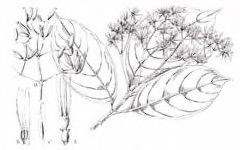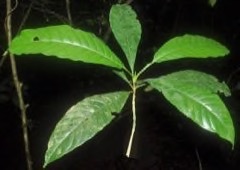 |
|
http://www.edibleplants.org |
 |
| korupplants.myspecies.info |
Translate this page:
Summary
Pausinystalia macroceras is an evergreen tree growing up to 40m in height. It has a straight, cylindrical trunk that can be up to 50cm in diameter. It can be found in West tropical Africa and is one of the five species in the Pausinystalia genus. The bark is used as an aphrodisiac and anti-hypnotic. It has similar medicinal properties and uses to that of Yohimbe (Pausinystalia johimbe). The wood is used for fuel and as construction material.
Physical Characteristics

 Pausinystalia macroceras is an evergreen Tree growing to 18 m (59ft) by 15 m (49ft) at a slow rate.
Pausinystalia macroceras is an evergreen Tree growing to 18 m (59ft) by 15 m (49ft) at a slow rate.
See above for USDA hardiness. It is hardy to UK zone 10.
Suitable for: medium (loamy) and heavy (clay) soils and prefers well-drained soil. Suitable pH: mildly acid, neutral and basic (mildly alkaline) soils. It can grow in semi-shade (light woodland). It prefers moist soil.
UK Hardiness Map
US Hardiness Map
Synonyms
Corynanthe bequaertii De Wild. Corynanthe gabonensis A.Chev. Corynanthe macroceras K.Schum. Pausinys
Plant Habitats
Edible Uses
References More on Edible Uses
Medicinal Uses
Plants For A Future can not take any responsibility for any adverse effects from the use of plants. Always seek advice from a professional before using a plant medicinally.
Aphrodisiac Cardiac Hallucinogenic Hypotensive Parasiticide Stimulant Vasodilator
The bark is very widely used as an aphrodisiac and anti-hypnotic[332 ]. The bark sap is applied topically to treat cutaneous and subcutaneous parasitic infections[332 ]. This species is closely related to Pausinystalia johimbe, and is said to have the same medicinal properties and uses[303 ]. These are:- The bark contains up to 6% of a mixture of indole alkaloids, the principle one being yohimbine (which is also known as aphrodine), plus pigments and tannins[254 , 418 ]. The alkaloids have a cerebral stimulant action at low doses, but are highly toxic in large doses[254 ]. Yohimbine has been shown to block the release of adrenalin and, in the correct dose, act as a sexual stimulant[238 ]. It is the source of the only clinically-proven cure for impotence and has long been used as a traditional stimulant in Africa[418 ]. Yohimbe is a bitter, warming, anti-diuretic, hypotensive and vasodilating herb with reputedly aphrodisiac effects[238 ]. It has a stimulant effect upon the heart, increasing heart rate and blood pressure; has a locally anaesthetic action similar to that of cocaine but without being mydriatic; is a mild stimulant that can help to prevent drowsiness; and is hallucinogenic. The vasodilating action of yohimbe is particularly strong on the sex organs, hence its aphrodisiac action[238 , 303 ]. The bark is taken internally, either as a powder or as a decoction. It is used particularly in the treatment of impotence, frigidity and angina[238 , 418 ]. It is also used as a performance enhancer for athletes, and as a remedy to increase the clarity of the voices of singers during long festivals[303 , 418 ]. The bark can be harvested at any time of the year[254 ]. The use of this herb is subject to legal restrictions in some countries[238 , 254 ].
References More on Medicinal Uses
The Bookshop: Edible Plant Books
Our Latest books on Perennial Plants For Food Forests and Permaculture Gardens in paperback or digital formats.

Edible Tropical Plants
Food Forest Plants for Hotter Conditions: 250+ Plants For Tropical Food Forests & Permaculture Gardens.
More

Edible Temperate Plants
Plants for Your Food Forest: 500 Plants for Temperate Food Forests & Permaculture Gardens.
More

More Books
PFAF have eight books available in paperback and digital formats. Browse the shop for more information.
Shop Now
Other Uses
Fuel Parasiticide Tannin Wood
Other Uses This species is closely related to Pausinystalia johimbe, and is said to have the same uses[303 ]. These are:- The bark is a source of tannins[418 ]. The inner bark is utilized as straps for panniers[303 ]. The tree produces very little sap-wood, the major fraction being an ocreous-yellow heart-wood[332 ]. The wood is flexible so iswidely used as a snare-trap mechanism, whilst the young poles are used for construction purposes in traditional buildings[303 ]. The wood is used as fuel[303 , 418 ].
Special Uses
References More on Other Uses
Cultivation details
None known. Pausinystalia macroceras occurs in lowland evergreen forest, primary as well as secondary, and also in gallery forest.
References Carbon Farming Information and Carbon Sequestration Information
Temperature Converter
Type a value in the Celsius field to convert the value to Fahrenheit:
Fahrenheit:
The PFAF Bookshop
Plants For A Future have a number of books available in paperback and digital form. Book titles include Edible Plants, Edible Perennials, Edible Trees,Edible Shrubs, Woodland Gardening, and Temperate Food Forest Plants. Our new book is Food Forest Plants For Hotter Conditions (Tropical and Sub-Tropical).
Shop Now
Plant Propagation
Seed -
Other Names
If available other names are mentioned here
False johimbe
Native Range
AFRICA: Cameroon, Democratic Republic of the Congo, Gabon, Equatorial Guinea, Nigeria, Angola (Cabinda)
Weed Potential
Right plant wrong place. We are currently updating this section.
Please note that a plant may be invasive in one area but may not in your area so it's worth checking.
Conservation Status
IUCN Red List of Threatened Plants Status : This taxon has not yet been assessed

Growth: S = slow M = medium F = fast. Soil: L = light (sandy) M = medium H = heavy (clay). pH: A = acid N = neutral B = basic (alkaline). Shade: F = full shade S = semi-shade N = no shade. Moisture: D = dry M = Moist We = wet Wa = water.
Now available:
Food Forest Plants for Mediterranean Conditions
350+ Perennial Plants For Mediterranean and Drier Food Forests and Permaculture Gardens.
[Paperback and eBook]
This is the third in Plants For A Future's series of plant guides for food forests tailored to
specific climate zones. Following volumes on temperate and tropical ecosystems, this book focuses
on species suited to Mediterranean conditions—regions with hot, dry summers and cool, wet winters,
often facing the added challenge of climate change.
Read More
Expert comment
Author
(K.Schum.) Pierre
Botanical References
Links / References
For a list of references used on this page please go here
A special thanks to Ken Fern for some of the information used on this page.
Readers comment
| Add a comment |
|
If you have important information about this plant that may help other users please add a comment or link below. Only comments or links that are felt to be directly relevant to a plant will be included. If you think a comment/link or information contained on this page is inaccurate or misleading we would welcome your feedback at [email protected]. If you have questions about a plant please use the Forum on this website as we do not have the resources to answer questions ourselves.
* Please note: the comments by website users are not necessarily those held by PFAF and may give misleading or inaccurate information.
To leave a comment please Register or login here All comments need to be approved so will not appear immediately.
|
Subject : Pausinystalia macroceras
|
|
|
|